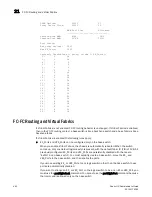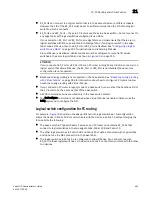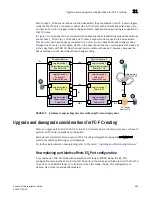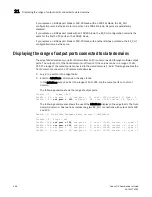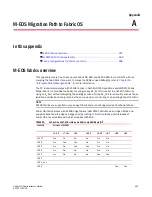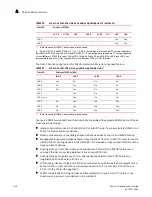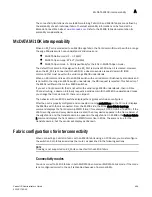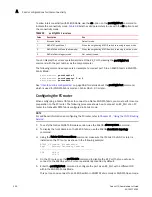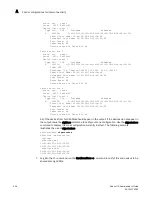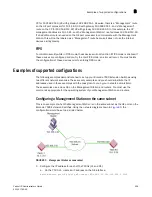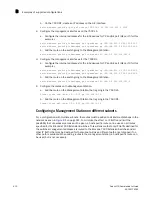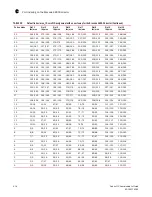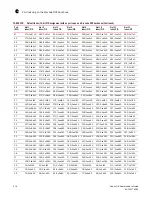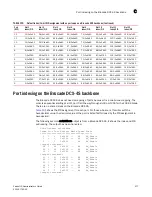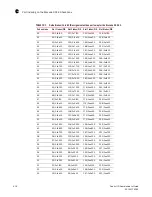
506
Fabric OS Administrator’s Guide
53-1001763-02
Internal Ethernet devices
B
Internal Ethernet devices
During the switch initialization process, a new internal Ethernet device is created. The devices
created are
inbd0
and
inbd1
. Ethernet device inbd0 is used to communicate through GE port 1 and
inbd1 is used to communicate through GE port 0. These new Ethernet interfaces are internal only
and are not accessible from outside the switch. They are used strictly for communicating IP packets
between the CP and the GE port processor.
Figure 79
shows the Inband Management process. During initialization, the hardware addresses
for inbd0 and inbd1 are initialized to create a hardware address that is unique for each Ethernet
interface. After the Ethernet device is initialized, it is enabled for use. At this point, the Ethernet
device can start sending and receiving Ethernet frames.
FIGURE 79
Inband Management process
The NAT IP table is loaded and automatically configured on startup.The source address NAT is
configured on the Inband Management interfaces to use the address of the CP management
interface (eth0). The switch automatically uses the IP address of the CP management interface for
the source address NAT for the new Inband Management interfaces, so no additional configuration
is required.
IP address and routing management
The CP and GE port processor Ethernet interfaces must have IP addresses associated with them.
By default, there will be no IP addresses associated with these new Ethernet interfaces. To manage
the IP addresses for the CP and GE port processor Ethernet interfaces, use the portCfg
inbandmgmt command on the CP.
Specifying the portCfg inbandmgmt command with the
routeadd or routedel options adds and
deletes route entries to and from the CP and the GE port processor routing tables. IP addresses
must be configured for both devices prior to configuring any routes. When configuring the routes for
the CP, the GE port processor inband device address for that GE port is used instead of the
Summary of Contents for 53-1001763-02
Page 1: ...53 1001763 02 13 September 2010 Fabric OS Administrator s Guide Supporting Fabric OS v6 4 0 ...
Page 4: ...iv Fabric OS Administrator s Guide 53 1001763 02 ...
Page 24: ...xxiv Fabric OS Administrator s Guide 53 1001763 02 ...
Page 28: ...xxviii Fabric OS Administrator s Guide 53 1001763 02 ...
Page 32: ...xxxii Fabric OS Administrator s Guide 53 1001763 02 ...
Page 40: ...xl Fabric OS Administrator s Guide 53 1001763 02 ...
Page 42: ...2 Fabric OS Administrator s Guide 53 1001763 02 ...
Page 54: ...14 Fabric OS Administrator s Guide 53 1001763 02 High availability of daemon processes 1 ...
Page 74: ...34 Fabric OS Administrator s Guide 53 1001763 02 Basic connections 2 ...
Page 102: ...62 Fabric OS Administrator s Guide 53 1001763 02 Audit log configuration 3 ...
Page 214: ...174 Fabric OS Administrator s Guide 53 1001763 02 Management interface security 7 ...
Page 228: ...188 Fabric OS Administrator s Guide 53 1001763 02 Brocade configuration form 8 ...
Page 276: ...236 Fabric OS Administrator s Guide 53 1001763 02 Creating a logical fabric using XISLs 10 ...
Page 404: ...364 Fabric OS Administrator s Guide 53 1001763 02 ...
Page 440: ...400 Fabric OS Administrator s Guide 53 1001763 02 Performance data collection 17 ...
Page 480: ...440 Fabric OS Administrator s Guide 53 1001763 02 F_Port masterless trunking 19 ...
Page 494: ...454 Fabric OS Administrator s Guide 53 1001763 02 Buffer credit recovery 20 ...
Page 574: ...534 Fabric OS Administrator s Guide 53 1001763 02 Hexadecimal overview E ...

